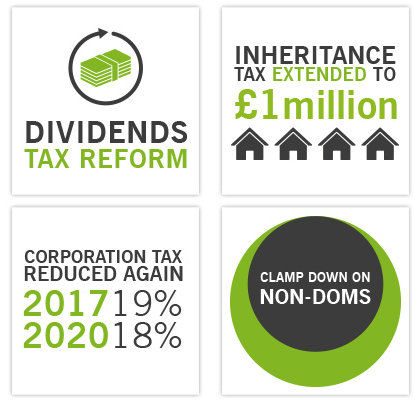
Living wage and other rabbits out of the Summer Budget bag
BLOG from Howard Chapman, Editor of Buildingtalk
Follow Buildingtalk on Twitter and subscribe the Buildingtalk newsletter
George Osbornes emergency summer Budget turned into one of the most comprehensive Budgets of the last 20 years.
The rabbit out of the bag, as I had predicted, was the move to a National Living Wage not least to reduce the costly low-pay subsidies paid by taxpayers to the benefit of profitable companies that pay poor wages and little tax. I also agree with the CIOB. They believe the government should go further and increase the minimum wage for apprentices, which would improve the appeal for individuals considering this route into industry.
Our Summer Budget 2015 report begins with the clichs and headlines, then onto construction industry and Trades Union comments, followed by a link to the best short summary and finally, for those who want the full monty, we have listed all 65 main points in the Budget.
Enjoy!
Top 5 Budget headline cliches
Budget that puts security first
Budget for working people
Higher wage, lower tax, lower welfare country
Fix the roof whilst the sun is shining
Northern Powerhouse
Impact on Housing
For housebuilders, changes to social rents that will have the most impact, with a 1% cut each year until the end of this parliament. That translates to a significant cut in income for housing associations and may put a dent in their development programmes as a result.
Howard Freedman, Baker Tillys Head of Real Estate and Construction summarises the impact of other changes:
- Buy to let: residential property landlords will only get reduced tax relief on their finance costs cutting welfare benefits will impact rental businesses significant impact on cash flows more higher rate tax paying landlords will undertake their rental business through companies
- Home owners: Rent-a-room relief to increase from andpound;4,250 to andpound;7,500
- Inheritance tax: government to extend inheritance tax to residential properties held indirectly, such as companies
- Annual investment allowance (AIA): Good news for commercial property businesses, allows them to obtain relief for significant refurbishment work
Mike Quinton, Chief Executive of NHBC comments on aimed at boosting levels of house-building:
NHBC registered 145,174 new homes for development in 2014 across the UK, up 9% on 2013, but with research showing that 245,000 homes are needed every year to meet demand, there is still some way to go. NHBC welcomes the launch of The Housing Growth Partnership earlier this week, which gives vital financial support to small and medium sized housebuilders. It also helps to increase the supply of new homes that our country so desperately needs.
Ian Westerling, Managing Director at Humberts offers Buildingtalk a final comment on housebuilding and the Budget:
With no mention of housebuilding, the Government has neglected to address the needs of the housing market and the lack of supply therewith. There is an urgent andessential need to meet the ongoing demand for more new housing stock in order to ensure a healthy and sustainable housing market.
Energy efficiency andamp; sustainability
Stable policy needed to support investment andamp; growth.
John Sinfield, Managing Director of Knauf Insulation said that recent stop-start changes to UK energy efficiency programmes have already reduced investment in the UK.
Without a clear, long term framework for delivering energy efficiency, the threat of rising utility costs risks slowing consumer spending across the economy. Further policy instability will also cause business investment to continue to go abroad, making existing commitments to tackle fuel poverty by 2030 incrementally harder to achieve.
A housing stock that is fit for modern usage reduces costs to the NHS. This has been acknowledged by the National Institute for Health and Care Excellence. It shows that upgrading our homes the infrastructure in which we live is part of making public spending more efficient, and improving the causes of ill health rather than treating the symptoms alone. But achieving any of these benefits requires an industry able to invest in the skills needed to finish the job. And this means a clear Government programme to support their own aims.
Planning legislation, regional investment andamp; road building
John Francis, of DPP Planning offers summary of the legislation changes to planning regulations and plans for regional investments
- Devolving powers on Sunday trading to city mayors and Local Authorities
- More Enterprise Zones with the government holding a bidding round for a new programme
- Northern Powerhouse, Midland Engine for Growth and other regional road infrastructure and local rail projects have seen funding confirmed or boosted, including plans to upgrade the A1(M)/M1 to motorway standard through to Newcastle
- Transport for the North (TfN) will be a new statutory body with andpound;30million budget to promote northern road and rail connectivity including a remit for a study into a new TransPennine Tunnel
- Devolution plans were confirmed for Greater Manchester including consultation on receiving even greater planning powers and a new Land Commission
Budget Summaries
- Budget included few measures that will impact directly upon construction.
- Chancellor reiterated the Governments commitment to building more homes and further planning reforms as due to be published on Friday.
- Reduction in mortgage tax relief for buy-to-let landlords will have little direct impact on new housing supply, although if it increases upward pressure on rents it may help encourage corporate investment in the private rented sector.
- Plans to ring fence vehicle excise duty for investment in the strategic road network appear to be largely a political statement: The change will not apply until the start of the next Parliament.
- Levy is planned on all large UK employers to fund an increase in apprenticeships. The implications for existing sector bodies such as CITB will be set out in this autumns Spending Review.
- Details of how a further andpound;15 billion of savings will be found through departmental spending cuts, and the potential implications for important construction markets, will be revealed in the autumn.
Chartered Institute of Building (CIOB)
Regional infrastructure
- Vital for economic growth. Although there is a clear case for devolution, local authorities will need to react quickly to harness the opportunities for local growth and employment. Whilst this announcement details a commitment to devolve more powers, it remains to be seen how effective implementation will be across the UK.
SME builders
- With a significant proportion of the construction industry either self-employed or linked to an SME, the announcement that SME builders will get a andpound;100m boost through the Housing Growth Partnership is welcome. However, more must be done to find solutions to the housing crisis and it is concerning that the Office for Budget Responsibility predicts there will be 14,000 fewer affordable homes built as a direct result of social housing rent cuts.
Employment allowance
- CIOB welcomes the rise in employment allowance to andpound;3,000, which will allow small firms to employ four people on the national living wage without paying any national insurance.
Apprenticeships:
- Target of delivering 3 million apprenticeships over the next five years equivalent to six hundred thousand new apprenticeships a year. The introduction of a new apprenticeship levy is a big ask for business, but one that recognises the acute skills shortages industries such as construction will face in the future unless significant investment is made in training.
National Living Wage
- CIOB now asks whether the government should go further and increase the minimum wage for apprentices, which is likely to improve the appeal for individuals considering this route into industry.
Comments from the construction Unions
- Paul Kenny, GMB General Secretary, said the Budget was a beautifully crafted con trick by Osborne which does not guarantee that workers will be better off.
- Described the Budget as an exercise to increase misery for social housing tenants and families on housing waiting lists.
Best Budget Summary
And finally
For those who want the full monty, here are the 65 main points in the July 2015 budget, as reported by Press Association.
1.Chancellor of the Exchequer George Osborne said it will be a Budget that puts security first a Budget for working people.
2.The Budget will take Britain from a low wage, high tax, high welfare economy, to the higher wage, lower tax, lower welfare country we intend to create.
3.Mr Osborne said: Britain still spends too much, borrows too much and our weak productivity shows we dont train enough or build enough or invest enough.
4.The Office for Budget Responsibility forecasts growth for 2015 at 2.4%, then 2.3% in 2016, then revised up to 2.4% in 2017, and for rest of decade.
5.Business investment is 31.9% higher than in 2010 and revised up again this year.
6.OBR forecasts almost 1 million new jobs over the next five years, but Mr Osborne says the Governments ambition is to go further and create 2 million more jobs.
7.The deficit should be cut during this Parliament at the same pace as we did in the last Parliament, said the Chancellor.
8.Mr Osborne said his plans will leave the national debt lower as a share of GDP in every future year than was predicted in March and will avoid a rollercoaster ride in public spending.
9.Banks including RBS to be returned to private sector faster than expected, with sale of Government assets delivering record privatisation proceeds this year.
10.Budgetsurplus to be achieved a year later than planned in 2019/20, but the national debt will be lower and the surplus larger than expected.
11.Deficit to fall to 3.7% of national income this year, then 2.2% in 2016/17, 1.2% in 2017/18 and 0.3% in 2018/19, before moving into surplus of 0.4% in 2019/20 and 0.5% in 2020/21.
12.Borrowing revised down to andpound;69.5 billion this year, then revised up to andpound;43.1 billion and andpound;24.3 billion the following two years and to reach andpound;6.4 billion in 2018/19.
13.Surplus forecast of andpound;10 billion in 2019/20 and andpound;11.6 billion in 2020/21.
14.National debt forecast to be 80.3% this year, then 79.1%, 77.2%, 74.7% and 71.5% in subsequent years before reaching 68.5% in 2020/21.
15.Chancellor publishes a new Fiscal Charter committing the country to running an overall budget surplus in normal economic times.
16.After 2019/20, deficit to be allowed only when the OBR judges real GDP growth is lower than 1% a year.
17.The fiscal plan requires andpound;37 billion of further consolidation over five years, including andpound;12 billion from welfare and andpound;5 billion from tackling tax evasion to be announced today, and the rest from departmental cuts to be announced in the autumn.
18.Rises in public sector pay restricted to 1% per year for the next four years.
19.NHS to receive a further andpound;8 billion by 2020, on top of andpound;2 billion already committed.
20.HM Revenue and Customs to receive extra andpound;750 million to go after tax fraud and evasion, with the aim of raising andpound;7.2 billion in extra tax.
21.Non-dom status abolished for people born in the UK to parents domiciled here. Permanent non-dom tax status to be abolished with anyone resident in the UK for more than 15 years of the past 20 years to pay full UK tax from April 2017, raising andpound;1.5 billion.
22.Bank levy rate to be gradually reduced over the next six years, while a new 8% surcharge on bank profits will be introduced from January 2016.
23.Cap on charges imposed by claims management companies, and an increase in insurance premium tax to 9.5%, effective from November 2015.
24.Funding from banking fines for services charities, with a quadrupling in annuities for Victoria Cross and George Cross holders. Government to fund memorial to victims of terrorism overseas.
25.Renovation of RAF group fighter command centre in West London, where the Battle of Britain was directed from, to be funded.
26.Plan for Productivity to be unveiled on Friday.
27.New bands for vehicle excise duty for brand new cars from 2017 – with most cars paying andpound;140 standard charge. No change to VED for existing cars.
28.All cash raised from VED in England from the end of this decade to go into a new Roads Fund to pay for investment.
29.Fuel duty to remain frozen this year.
30.New apprenticeship levy on all large firms.
31.University maintenance grants to be replaced by loans for new students from 2016/17 academic year to be paid back once they earn more than andpound;21,000. Maximum loan increased to andpound;8,200.
32.University tuition fee cap to be linked to inflation for institutions offering high-quality teaching.
33.Agreement reached with 10 councils in Greater Manchester to devolve further powers to the city.
34.Government working towards deals with Sheffield, Liverpool and West Yorkshire regions on far-reaching devolution of power in return for the creation of directly-elected mayors.
35.Regius professorships to be created in universities across the country to mark the Queens 90th birthday.
36.Counties and elected mayors to gain power to set Sunday trading hours in their areas.
37.Mortgage interest relief on residential property to be restricted to the basic rate of income tax, phased in over four years from April 2017.
38.Tax relief for homeowners who rent out a room to be increased from andpound;4,250 to andpound;7,500 from next year.
39.New inheritance tax allowance of andpound;175,000 on homes left to children or grandchildren from 2017, allowing andpound;1 million to be passed on tax-free. Reforms will ensure that those who downsize do not lose any of the allowance.
40.Pensions tax annual allowance to be tapered away to a minimum of andpound;10,000 from next year.
41.Green paper published on proposals for a radical change to pension saving system.
42.Annual Investment Allowance for small and medium-sized businesses to be set at andpound;200,000 from this year.
43.Climate Change Levy exemption for renewable electricity to be removed.
44.Dividend tax credit to be replaced with a new tax-free allowance of andpound;5,000 on dividend
45.Corporation tax to be cut from 20% to 19% in 2017 and 18% by 2020.
46.Disability benefits will not be taxed or means-tested, and funding for domestic abuse victims and womens refuges will be increased.
47.Abolition of automatic entitlement to housing benefit for 18 to 21 year olds, who will have a new Youth Obligation requiring them to earn or learn. Exemptions for vulnerable people.
48.Rate of Employment and Support Allowance paid to those deemed able to work to be aligned with Jobseekers Allowance for new claimants.
49.Working-age benefits to be frozen for four years – including tax credits and local housing allowance, but excluding maternity pay and disability benefits.
50.Rents in the social housing sector to be reduced by 1% a year for the next four years.
51.Income threshold for tax credits to be reduced from andpound;6,420 to andpound;3,850, with similar reductions for Universal Credit work allowances, which will no longer be awarded to non-disabled claimants without children.
52.The rate at which a households tax credit is reduced as it earns more is to be increased to 48%, and the income rise disregard reduced from andpound;5,000 to andpound;2,500.
53.Benefits cap to be reduced from andpound;26,000 per household to andpound;23,000 in London and andpound;20,000 in the rest of the country. Social housing tenants earning more than andpound;40,000 in London and andpound;30,000 elsewhere to pay rent at market rates.
54.Support for children through tax credits and universal credits to be limited to two children, affecting children born after April 2017.
55.Changes to tax credits bring spending on the benefit back to 2007/08 level in real terms.
56.Welfare reforms announced by the Chancellor will save andpound;12 billion by 2019/20 and will be legislated for over the coming year.
57.Tax-free personal allowance for income tax to be raised from andpound;10,600 to andpound;11,000 next year. Rates of income tax remain unchanged.
58.Higher rate income tax threshold to rise from andpound;42,385 to andpound;43,000 from next year, lifting 130,000 people out of the higher rate.
59.Real terms increase in the defence budget guaranteed every year, and a new joint security fund of andpound;1.5 billion a year to be created by 2020.
60.Commitment for the UK to meet the Nato pledge of spending 2% of national income on defence every year of this decade.
61.Introduction of a new compulsory National Living Wage for working people aged 25 and over, starting in April 2016 at andpound;7.20 an hour and reaching andpound;9 an hour by 2020.
62.Low Pay Commission to recommend future rises in National Living Wage to reach 60% of median earnings by 2020.
63.OBR estimates National Living Wage will cost business 1% of corporate profits and result in 60,000 fewer jobs by 2020, but that by that time almost 1 million more will have been created.
64.National Insurance employment allowance for small firms to be increased by 50% to andpound;3,000 from 2016.
65.Changes will mean a direct pay rise for 2.5 million with those on the minimum wage seeing pay increase by more than one third over the Parliament – or more than andpound;5,000 for a full-time worker. A total of 6 million people expected to see their pay increase overall.
SEND YOUR COMMENTS TO BUILDINGTALK
READ MORE BLOGS
COMMENTS
The Independent via Twitter 10/7/15
GeorgeOsbornes new housing policy will cut 14K affordable house building say Housing Associations
Latest news

16th April 2024
Mitsubishi Electric set to host CIBSE Journal webinar
Mitsubishi Electric will host a CIBSE Journal webinar on Wednesday 24th April 2024 at 1pm to discuss the legislation and initiatives driving changes in the way we will need to heat, cool and ventilate large commercial buildings to reach net zero emissions in the UK.
Posted in Air Conditioning, Articles, Building Industry Events, Building Industry News, Building Products & Structures, Building Regulations & Accreditations, Building Services, Facility Management & Building Services, Heating Systems, Controls and Management, Heating, Ventilation and Air Conditioning - HVAC, Information Technology, Pipes & Fittings, Plumbing, Seminars, Sustainability & Energy Efficiency, Training
16th April 2024
Hamworthy: What to consider when choosing a heat pump?
At the heart of an efficient heat pump system lies an important element: the refrigerant – Jason Allen, Commercial Product Manager, Groupe Atlantic UK, ROI & NA. Hamworthy Heating is a Groupe Atlantic brand.
Posted in Articles, Building Industry News, Building Products & Structures, Building Services, Facility Management & Building Services, Heating Systems, Controls and Management, Heating, Ventilation and Air Conditioning - HVAC, Pipes & Fittings, Plumbing, Retrofit & Renovation, Sustainability & Energy Efficiency
15th April 2024
EJOT Colorfast chosen for Kingspan’s highly sustainable new Asian factory
More than 120,000 EJOT Colorfast self-drilling fasteners have helped Kingspan to create a thermally superior, visually-appealing building envelope for its first purpose-built manufacturing plant in South East Asia.
Posted in Articles, Building Industry News, Building Products & Structures, Building Systems, Case Studies, Posts, Restoration & Refurbishment, Retrofit & Renovation, Roofs, Sustainability & Energy Efficiency
15th April 2024
ASSA ABLOY helps new manufacturing plant achieve LEED Gold certification
Improving sustainability performance is becoming a higher priority for building developers, owners and users. One consequence is fast-growing demand for green building certifications — and therefore specification. Specialist input can make the difference between hitting and missing a project target, as ASSA ABLOY explains here…
Posted in Access Control & Door Entry Systems, Architectural Ironmongery, Articles, BIM, Infrastructure & CAD Software, Building Industry News, Building Products & Structures, Building Regulations & Accreditations, Building Services, Case Studies, Doors, Facility Management & Building Services, Information Technology, Retrofit & Renovation, Security and Fire Protection, Sustainability & Energy Efficiency
 Sign up:
Sign up: